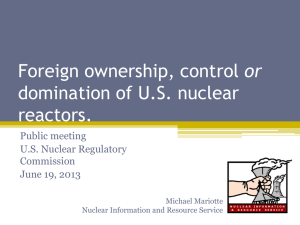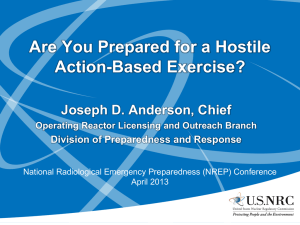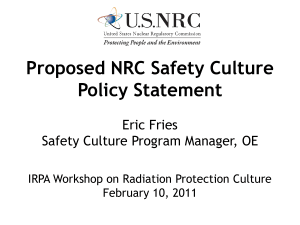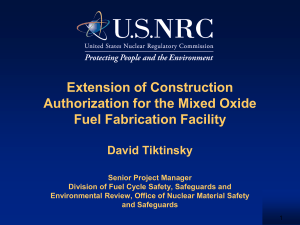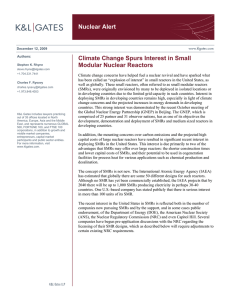(SMR) Licensing Insights
advertisement
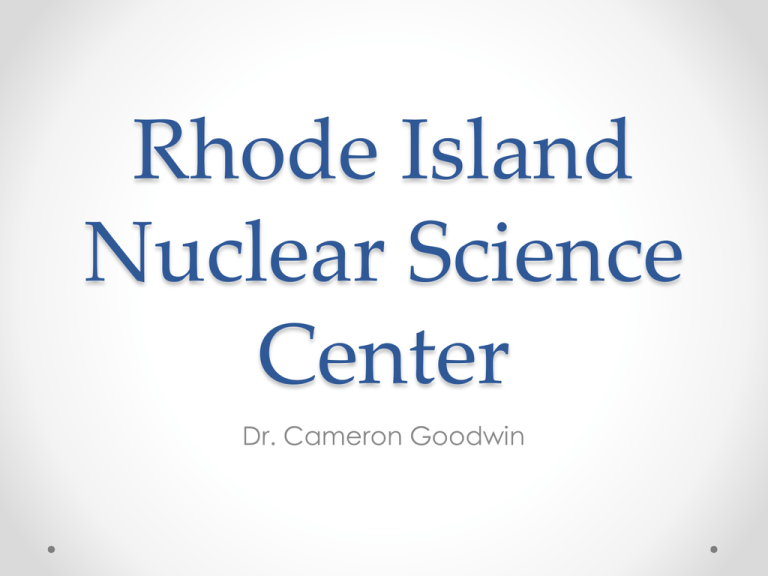
Rhode Island Nuclear Science Center Dr. Cameron Goodwin RINSC Reactor • Owned by the State • 2 MW pool type nuclear reactor • Located on the Bay Campus of URI • Used for research, education, and industry services RINSC Facilities • Six beam tubes for neutron experiments • One tangential thru tube • A thermal column for thermal neutron use • Gamma ray experiment facilities • Two pneumatic tube systems for activation analysis • A flux trap & adjacent core locations for long irradiations Past and Current Uses • High Level Gamma Irradiation o Solar Radiation Experiments • Neutron Scattering o Materials Studies o Protein Studies • Neutron Activation Analysis o Atmospheric Chemistry o Cell Tracking / BioMed • BioPal o Kidney Failure Diagnostics • Educational o o o o URI Providence College Three Rivers Community College High Schools SMR Licensing Insights What is a SMR? • Advanced Reactors o Those reactors whose designs are not similar to the LLW designs o SMR is a subset • Small modular reactor • Less than 300 MW • SMRs are envisioned to require limited on-site preparation and substantially reduce the lengthy construction times that are typical of the larger units. • Additional modules can be added incrementally as demand for energy increases. • Includes iPWR but is not limited to o Other designs • HTGR • SFR • LMR Benefits of SMRs • SMRs offer the advantage of lower initial capital investment, scalability, and siting flexibility at locations unable to accommodate more traditional larger reactors. o o o o Lower Capital Investment Scalability Siting Flexibility Gain Efficiency Benefits Cont’d • Nonproliferation: SMRs also provide safety and potential nonproliferation benefits to the United States and the wider international community. o Most built below grade for safety and security enhancements, addressing vulnerabilities to both sabotage and natural phenomena hazard scenarios. o Some designed to operate for extended periods without refueling. • International Marketplace: There is both a domestic and international market for SMRs. iPWR SMR Designs • • • • mPower Westinghouse NuScale Holtec mPower Design mPower Review • DOE FOA Award o Awarded to the mPower America team of Babcock & Wilcox, Tennessee Valley Authority, and Bechtel, includes efforts to complete design certifications, site characterization, licensing, first-of-a-kind engineering activities, and the associated NRC review processes. o The goal of this program is to support commercial operations of an SMR by 2022; the mPower team has developed a plan that expects to achieve a commercial operation date of October 2021. • Key Activities for the mPower America team include: o Submit Design Certification application to the NRC by mid-2014 for approval by 2018 o Perform site characterization at TVA’s Clinch River Site o Submit a Construction Permit Application to the NRC by mid-2015 for approval by 2018 o Advance the balance of plant design o Grow the U.S. based supply chain by mitigating challenges to domestic market entry and broad commercialization mPower and the NRC • Pre-application interactions o Public meetings monthly • NRC is working on a Design Specific Review Standard (DSRS) o Draft is completed o Final will be completed by time of application o This process compared the mPower design with the current SRP and allowed the NRC reviewers to note differences o Chapter 7 completely revised and restructured; • Intended to promote efficient, effective risk-informed reviews • Top-down approach where greater emphasis is placed on design principles – redundancy, independence, diversity and defense-indepth, predictability and repeatability • Part 50 – Clinch River Westinghouse Design Westinghouse SMR Review • Competing for 2nd FOA o No announcement as of yet • Review expected to begin 2nd Qtr 2014 • No DSRS o Westinghouse will be relying on SRP • Design is smaller version of AP1000 o This could increase length of review • Pre-application interactions have ramped up since Summer 2013 NuScale NuScale Review Competing for 2nd DOE FOA Application expected 3rd Qtr 2015 NRC is currently working on developing Draft DSRS Many public meetings are being held for preapplication • Biggest hurdle for design is Control Room Staffing • • • • Holtec Holtec Review • Applied for 2nd DOE FOA • Expected 4th Qtr CY16 • Limited pre-application interactions at this time NRC’s Advanced Reactor Program • Focused on preparing the agency for reviews of applications related to the design, construction and operation of advanced reactors o Identify and resolve significant policy, technical and licensing issues o Develop the regulatory framework to support efficient and timely licensing reviews o Engage in research focused on key areas to support licensing reviews o Engage reactor designers, potential applicants, industry and DOE in meaningful pre-application interactions o Establish an advanced reactors training curriculum for NRC staff o Remain cognizant of international developments and programs Known SMR Licensing Issues • Emergency Planning o Source term o Security o EPZ • Control Room Staffing o Control of multiple units o Reactor Operator Requirements o Control Room Design/Layout • Identification of shared systems o How to employ PRA o Implementation of control system architectures • Licensing of construction and operation of subsequent modules with operating modules • Annual Fees • Modularity Pre-Application Licensing Challenges • Level of design information available in pre-application o Ideal • Design complete enough to inform all review sections o Reality • Varying levels of design completion for each review section • Potential efficiency gains in review process by working activities in pre-application phase • Review process aided by improved documentation in applications (e.g., fewer RAIs) • More knowledge about the design • Earlier engagement of public stakeholders in the review process • Vendor participation required for success Non-LWR Work • Aging workforce at NRC o Little to no non-LWR experience • NGNP Review o ADAMS Accession No. ML13002A157 o Final NRC feedback addresses • Licensing basis event selection o Naming conventions for event categories o Frequency cutoffs for DBE and BDBE regions o Proposed process and categorization • Mechanistic Source terms o DOE/INL’s proposed mechanistic approach is consistent with NRC Commission approved positions Non-LWRs Cont’d • Containment functional performance o NRC staff stated that more fuel testing needed to be performed • Emergency preparedness o The NRC staff is open to considering alternative treatment of EP for advanced reactors • Review of GIF SFR Design Criteria • Generic GDCs o Since GDCs in Appendix A are specific to light-water reactors (LWRs), this requirement is especially challenging for potential future licensing applicants pursuing advanced (non-LWR) technologies and designs. o DOE-NE and NRC agree that consideration should be given to pursuing the following objective: • Develop generic GDCs (derived from Appendix A of 10 CFR 50) and develop technology-specific GDCs for at least one reactor type (TBD) to supplement the generic GDCs for compliance with 10 CFR 50.34., 52.47 and 52.79. Who to Contact at NRC? • SMRs are handled by the Office of New Reactors o Division of Advanced Reactors and Regulations – Mike Mayfield o Split into two branches • Stu Magruder o Stewart.magruder@nrc.gov • Anna Bradford o Anna.bradford@nrc.gov • Electronic Distribution of SMR Documents o http://www.nrc.gov/public-involve/listserver.html Questions?




